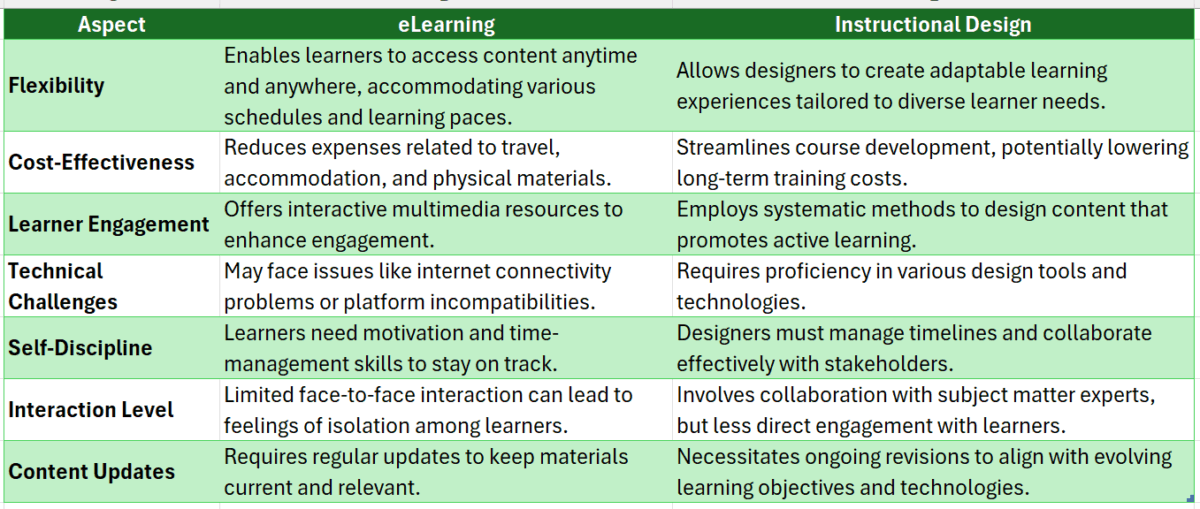
In today’s fast-paced world, understanding how eLearning and instructional design strategies is crucial. With technology shaping education, eLearning offers innovative ways to engage learners. This shift not only makes learning more accessible but also enriches the instructional design curriculum, allowing educators to create more effective and interactive experiences.
The Benefits of eLearning in Instructional Design
- Flexibility: eLearning allows learners to study at their own pace, fitting education into their busy lives.
- Engagement: Interactive elements, like quizzes and videos, keep learners interested and motivated.
- Accessibility: With online resources, students from various backgrounds can access quality education, breaking down geographical barriers.
Curriculum Design Example
For instance, consider a curriculum design example that incorporates eLearning. A traditional course on environmental science can be transformed by adding online simulations and virtual labs. This not only enhances understanding but also allows students to apply concepts in real-world scenarios, making learning more relevant and impactful.
Start your journey to a brighter future—Enroll now!
How eLearning Facilitates Personalized Learning Experiences

In today’s fast-paced world, understanding how eLearning enhances instructional design strategies is crucial. It allows educators to create more effective and engaging learning experiences. By integrating technology into the instructional design curriculum, teachers can tailor lessons to meet individual student needs, making learning more accessible and enjoyable.
Tailored Learning Paths
- Flexibility: eLearning allows students to learn at their own pace, choosing when and how they engage with the material.
- Diverse Resources: With various multimedia tools, students can explore topics through videos, quizzes, and interactive activities, catering to different learning styles.
Real-Time Feedback
- Instant Assessment: eLearning platforms provide immediate feedback, helping students understand their strengths and areas for improvement.
- Adaptive Learning: Instructional design can adjust based on student performance, ensuring that each learner receives the support they need to succeed.
By incorporating these elements into the curriculum design example, educators can create a more personalized and effective learning environment. This not only boosts student engagement but also enhances overall learning outcomes, making eLearning a powerful tool in modern education.
The Impact of Interactive Content on Engagement in Instructional Design
In today’s fast-paced world, understanding how eLearning enhances instructional design strategies is crucial. It allows educators to create engaging and effective learning experiences. By incorporating interactive content, instructional design can transform traditional methods into dynamic learning journeys that captivate students’ attention.
Why Interactive Content Matters
Interactive content, like quizzes and simulations, makes learning fun. It encourages students to participate actively rather than passively absorbing information. This engagement is vital in an instructional design curriculum, as it helps learners retain knowledge better.
Benefits of Interactive Content
- Increased Engagement: Students are more likely to stay focused when they interact with the material.
- Immediate Feedback: Quizzes provide instant results, helping learners understand their progress.
- Real-World Applications: Curriculum design examples that include simulations prepare students for real-life scenarios, making learning relevant and practical.
Can eLearning Strategies Improve Knowledge Retention?
In today’s fast-paced world, understanding how eLearning enhances instructional design strategies is crucial. With technology evolving, educators are seeking innovative ways to engage students and improve learning outcomes. eLearning offers unique opportunities to create dynamic instructional design curricula that cater to diverse learning styles.
Engaging Learning Experiences
eLearning allows for interactive and engaging learning experiences. By incorporating multimedia elements like videos, quizzes, and simulations, learners can connect with the material better. This engagement is key to improving knowledge retention, making the instructional design curriculum more effective.
Flexibility and Accessibility
Another benefit of eLearning is its flexibility. Students can learn at their own pace, revisiting challenging topics as needed. This accessibility ensures that everyone can grasp the concepts, leading to a deeper understanding. For example, a curriculum design example might include online modules that students can access anytime, anywhere.
Leveraging Technology: Tools That Enhance Instructional Design
In today’s fast-paced world, eLearning has become a game-changer in enhancing instructional design strategies. By integrating technology into the learning process, educators can create more engaging and effective instructional design curriculums. This not only benefits students but also empowers teachers to deliver content in innovative ways.
Interactive Learning Tools
- Multimedia Content: Incorporating videos, podcasts, and interactive quizzes can make lessons more engaging.
- Learning Management Systems (LMS): Platforms like Moodle or Canvas help organize and deliver instructional design curriculums efficiently.
Real-Time Feedback
With eLearning, students receive instant feedback on their progress. This allows for timely adjustments in their learning paths, making curriculum design examples more effective and personalized.
Collaboration and Community
- Discussion Forums: These platforms encourage students to share ideas and ask questions, fostering a sense of community.
- Group Projects: E-learning tools enable collaborative projects, enhancing teamwork skills among students.
By leveraging these technologies, educators can significantly enhance their instructional design strategies, making learning more accessible and enjoyable for everyone.
The Benefits of Asynchronous Learning in eLearning Environments
In today’s fast-paced world, understanding how eLearning enhances instructional design strategies is crucial. With the rise of digital education, it’s essential to explore how these methods can improve learning experiences. One key aspect is asynchronous learning, which allows students to learn at their own pace, making education more accessible and flexible.
Flexibility and Convenience
Asynchronous learning provides students with the freedom to choose when and where they study. This flexibility is a game-changer for many, especially those balancing work or family commitments. It aligns perfectly with modern instructional design curriculum, allowing learners to engage with materials when they are most ready to absorb information.
Personalized Learning Experience
In eLearning, students can revisit lessons and resources as needed. This personalization helps cater to different learning styles, making instructional design more effective. For example, a curriculum design example might include interactive quizzes or videos that students can access anytime, enhancing their understanding and retention of the material.
How to Integrate Multimedia Elements into Instructional Design
In today’s fast-paced world, eLearning is revolutionizing how we approach instructional design. By integrating multimedia elements, we can create more engaging and effective learning experiences. This matters because a well-designed instructional design curriculum can significantly enhance knowledge retention and learner satisfaction.
To effectively incorporate multimedia into your instructional design, consider these strategies:
- Use Videos: Short, informative videos can break down complex topics, making them easier to understand.
- Interactive Quizzes: These keep learners engaged and provide instant feedback, reinforcing their knowledge.
- Infographics: Visual representations of information can simplify data and make it more digestible.
Benefits of Multimedia in eLearning
Integrating multimedia into your curriculum design example can lead to:
- Improved engagement: Learners are more likely to stay focused with varied content.
- Enhanced understanding: Different formats cater to various learning styles, making information accessible to everyone.
- Increased retention: Engaging materials help learners remember information longer. By embracing these multimedia elements, your instructional design can truly shine!
Start your journey to a brighter future—Enroll now!
Measuring Success: Evaluating eLearning Effectiveness in Instructional Strategies
When we think about how eLearning enhances instructional design strategies, it’s crucial to understand its impact on learning outcomes. eLearning provides flexibility and accessibility, making it easier for students to engage with the material. This matters because effective instructional design can lead to better retention and understanding of concepts.
Key Benefits of eLearning in Instructional Design
- Personalized Learning: eLearning allows for tailored experiences, catering to individual learning paces and styles.
- Interactive Content: Engaging multimedia elements keep learners interested and motivated.
- Real-Time Feedback: Instant assessments help learners identify areas for improvement quickly, enhancing the instructional design curriculum.
To illustrate, consider a curriculum design example where students learn through interactive simulations. This method not only makes learning fun but also reinforces concepts through practical application. By measuring success through assessments and feedback, educators can refine their instructional strategies, ensuring they meet the needs of all learners.
What Are the Challenges of Implementing eLearning in Instructional Design?
Implementing eLearning in instructional design can be a game-changer, but it comes with its own set of challenges. Understanding these hurdles is crucial for educators and designers who want to create effective instructional design curricula. Let’s explore what these challenges are and how they can be overcome.
Technical Issues
- Access to Technology: Not all students have the same access to devices or reliable internet, which can hinder their learning experience.
- Platform Familiarity: Some learners may struggle with new eLearning platforms, making it essential to provide adequate training.
Content Development
- Quality of Materials: Creating engaging and interactive content for an instructional design curriculum can be time-consuming.
- Alignment with Learning Objectives: Ensuring that eLearning materials align with curriculum design examples is vital for effective learning outcomes.
By addressing these challenges, educators can harness the full potential of eLearning to enhance their instructional design strategies.
Discover How DegreeOnline.Education Can Transform Your eLearning Experience
In today’s fast-paced world, understanding how eLearning enhances instructional design strategies is crucial. With the rise of digital learning, educators and trainers can create more engaging and effective experiences. This transformation not only benefits learners but also empowers instructors to refine their teaching methods. Let’s explore how eLearning can elevate your instructional design curriculum.
Benefits of eLearning in Instructional Design
- Flexibility: eLearning allows learners to access materials anytime, anywhere, making it easier to fit education into busy schedules.
- Interactivity: Engaging multimedia elements, like videos and quizzes, can make learning more enjoyable and memorable.
- Personalization: With eLearning, instructional design can be tailored to meet individual needs, ensuring that every learner progresses at their own pace.
Curriculum Design Example
Imagine a curriculum design example where students can choose their learning paths. By integrating eLearning, instructors can offer various modules that cater to different interests and skill levels. This approach not only keeps students motivated but also enhances their understanding of the material. Discover how DegreeOnline.Education can transform your eLearning experience and make learning more effective!
Start your journey to a brighter future—Enroll now!
FAQs
1. What is instructional design?
Instructional design is the process of creating effective and engaging learning experiences, often using research-based methods to structure content and activities for optimal learning.
2. What is eLearning?
eLearning refers to any learning delivered electronically, typically via the internet. It includes online courses, virtual classrooms, and interactive modules.
3. How do instructional designers support eLearning?
They plan, develop, and organize digital learning experiences by analyzing learner needs, setting objectives, designing content, and selecting appropriate technologies.
4. What skills are important for instructional designers?
Key skills include curriculum design, learning theory, multimedia tools, eLearning software (like Articulate or Captivate), and assessment development.
5. What are common eLearning tools?
Popular tools include Articulate Storyline, Adobe Captivate, Camtasia, Moodle, and Learning Management Systems (LMS) like Canvas or Blackboard.
6. Is instructional design only for online learning?
No. Instructional design is used for both online and in-person learning environments, including corporate training, higher education, and K–12 settings.




